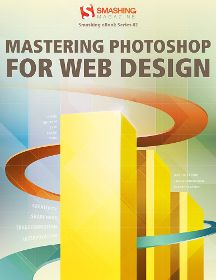Smashing eBook #3: Mastering Photoshop for Web Design
Mastering Photoshop is written for advanced and intermediate designers who want to brush up on their workflow and improve their Photoshop skills. The eBook contains 178 pages, explaining fundamental techniques that Web designers need to know to produce high-quality work in Photoshop. You won’t find any generic step-by-step tutorials or learn random effects. You will gain a profound understanding of what you can do with Photoshop and how to use it effectively in your work. All chapters have undergone a careful technical review by well-known designer, illustrator and speaker Elliot Jay Stocks. The book was proofread by our regular proofreader Andrew Lobo, and it has an attractive layout.
The author Thomas Giannattasio is an interactive designer who resides in the Washington DC metro area. He specializes in Web design and front-end development, particularly art direction, website design and application design, and has 14 years of experience. Thomas cares strongly about typography, simplicity and user experience. He works as a senior designer for a global marketing firm and freelances under the name attasi.
Thomas’ articles on Smashing Magazine prove his expertise in Photoshop: The Ails of Typographic Anti-Aliasing and Unknown Photoshop Tricks and Time-Savers are two of the most useful Photoshop-related articles that Smashing Magazine www.smashingmagazine.com, a leading online magazine for professional Web designers and developers, has published over the years.
The book contains eight chapters:
- Color Management
Colors can appear lighter or darker, more or less saturated, cooler or warmer, or just plain wrong depending on the user’s environment. This can be quite a problem, especially with a client’s brand-specific colors. As Web designers, our responsibility is to ensure that the experiences we craft are as true to the original as possible. - Paths
While Illustrator’s vector tools are much more powerful, Photoshop’s benefit lies in its ability to blend vector and raster data together seamlessly. Because Photoshop documents are based on a pixel grid, the path tools in Photoshop make them superior to Illustrator for designing on-screen media. - Layer Styles
Layer Styles are essential to creating flexible and non-degradable documents, because they’re separated from the layer’s actual content. In this chapter, we’ll cover how to create great-looking and reusable styles. We’ll also cover some unique effects and non-typical uses that help to consolidate excess layers. - Brushes
Mastering the digital brush is by no means easy. It carries the same difficulties as the sable brush hidden at the bottom of your art bin. In fact, the difficulty is multiplied by the disconnect between the hand and monitor. Developing Photoshop brush skill takes time, but it is well worth the effort. - Typography
While the majority of type on the Web is rendered by HTML, Photoshop is still necessary to handle treatment beyond the grasp of CSS. In this chapter, we’ll explore Photoshop’s type tools and discover ways to maximize the software’s typesetting capabilities. - Photography
A photograph—especially of the human face—immediately draws the user’s attention and can be used to direct eye flow to important areas of the page. Placing a large photograph above the fold is a common way to provide an entry point to the content. Because photographs are high above other elements in the hierarchy, they need to be handled with care and precision. - Exporting
Once you’ve polished every last pixel, it’s time to get your work into the browser. This is a pretty straightforward process, but properly optimizing your images is crucial. You need to maintain a balance between clarity and download speed. This requires multiple formats, varying levels of compression and other optimization techniques. In this chapter, we’ll explore the workflow of exporting images via the “Save for Web and Devices” dialog. - Summary
In the foreword, Thomas describes his motivation:
"The fast pace of the Internet has focused us on the latest and greatest techniques, which typically have a lifespan of only a few months. Rarely do we focus on the fundamentals—the principles that outlive the trends. Unfortunately, the principles often appeal to us less than the shiny and new.
Photoshop tutorials offer quick results. They hold our hands step by step until something incredible appears, but they rarely explain in depth the principles that allow us to create something unique and incredible of our own. If you’re a beginner, I hope this book gives you the comprehension you need to bring your ideas to life. If you’re a veteran, I hope it unveils some of the mysteries that have always boggled you."
weniger anzeigen expand_lessVersandkostenfreie Lieferung! (eBook-Download)
Als Sofort-Download verfügbar
- Artikel-Nr.: SW337046
- Artikelnummer SW337046
-
Autor
Thomas Giannattasio
- Verlag Smashing Media
- Seitenzahl 178
- Veröffentlichung 01.01.2011
- Verlag Smashing Media

